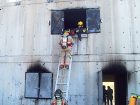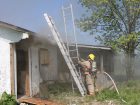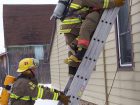
Features
Structural
Training
Back to Basics June 2017: Heeling the ladder from the front
Learning the basics isn’t always by the book. It takes practice to get things right and a page is no match for practical application.
May 24, 2017
By Mark van der Feyst
Textbooks help us learn and develop as firefighters, but sometimes they miss the mark when it comes to application. This is where instructors come in. Our job is to interpret textbook information and apply it to real situations.
During the ladder segment of a recruit class I was teaching, I noticed that every firefighter was heeling the ladder from behind. Why? Because this is what the textbook instructed them to do.
When I told the firefighters they should try heeling from the front instead, they were visibly surprised, responding to my suggestion with confused expressions.
Simply put, heeling the ground ladder from the front is more efficient and effective than heeling from behind.
Use your foot to heel the butt of the ladder, while your hands press against the ladder beams. This practical application is not always conveyed in the most commonly used textbooks, but when applied in real life, it makes sense (see photo 1).
In most cases, firefighters work within the limitations of a small crew. Not every department has the luxury of having three or four firefighters available to put up a ground ladder. Firefighters need to learn how to work with available resources.
When firefighters heel the ground ladder from behind, it removes one of the firefighters from the team. Once they are committed to holding that position, they are unable to perform other fire-ground tasks.
When firefighters heel a ground ladder from behind, they aren’t able to view the entire scene, nor can they help see the operation through to the end. Their vision is drastically impaired. The heeling firefighter’s gear, SCBA and helmet can restrict his or her ability to look up the ladder while others climb. Some firefighters’ helmets hit the top of the SCBA cylinder, or the front brim blocks a part of the view. Either way, the firefighter is hindered and the operation becomes dangerous.
When a ladder is heeled from the front, it is possible to observe the whole side of the building, the fire, any potential hazards and keep an eye on the firefighter climbing the ladder. A firefighter who heels from the front is still able to be an active member of the team (see photo 2).
Heeling a ground ladder from behind also makes firefighters vulnerable to falling hazards. Firefighters climbing a ladder often carry hand tools and other potentially dangerous objects. These items can fall. There is a very good chance that something dropped by a climbing firefighter will hit the head of the heeling firefighter.
For example, when a firefighter breaks glass while atop a ground ladder, that glass could fall on the heeling firefighter.
Has an instructor ever told you to not look up while heeling a ladder from behind? This is so that you do not have falling tools, broken glass or debris hit your face. When you look up, you expose your neck, mouth and eyes to whatever may be falling on you.
What if the firefighter climbing the ladder slips or loses balance? Is it possible for the firefighter who is heeling the ladder from behind to run to the front of the ladder and catch the falling firefighter? How fast can this be done? The answer: not very quickly!
However, if the firefighter were heeling the ground ladder from the front, he or she could quickly assist the other firefighter and still be a part of the team (see photo 3).
My students learned that heeling a ladder from the front is a safer and more efficient choice. Textbooks are definitely useful tools, but sometimes the most practical application isn’t printed on paper.
Mark van der Feyst has been in the fire service since 1999 and is a full-time firefighter in Ontario. Mark teaches in Canada, the United States and India and is a local-level suppression instructor for the Pennsylvania State Fire Academy and an instructor for the Justice Institute of BC. He is also the lead author of Residential Fire Rescue. Email Mark at Mark@FireStarTraining.com
Print this page
Advertisement
- Leadership Forum: Guiding recruits up the management ladder
- Stopbad June 2017: Avoid bad calls with better training


